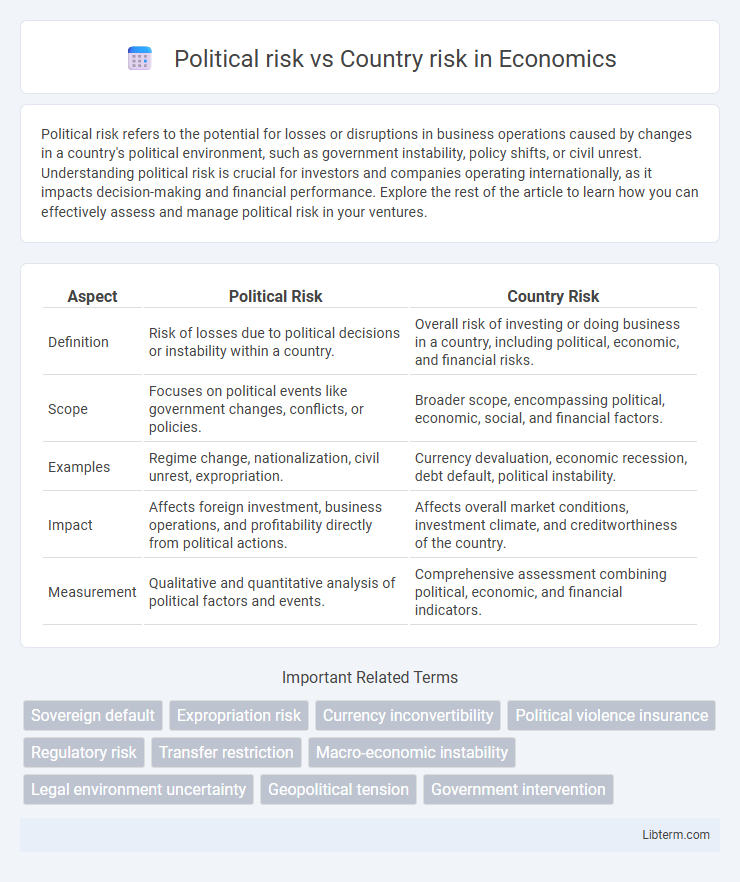Political risk refers to the potential for losses or disruptions in business operations caused by changes in a country's political environment, such as government instability, policy shifts, or civil unrest. Understanding political risk is crucial for investors and companies operating internationally, as it impacts decision-making and financial performance. Explore the rest of the article to learn how you can effectively assess and manage political risk in your ventures.
Table of Comparison
| Aspect | Political Risk | Country Risk |
|---|---|---|
| Definition | Risk of losses due to political decisions or instability within a country. | Overall risk of investing or doing business in a country, including political, economic, and financial risks. |
| Scope | Focuses on political events like government changes, conflicts, or policies. | Broader scope, encompassing political, economic, social, and financial factors. |
| Examples | Regime change, nationalization, civil unrest, expropriation. | Currency devaluation, economic recession, debt default, political instability. |
| Impact | Affects foreign investment, business operations, and profitability directly from political actions. | Affects overall market conditions, investment climate, and creditworthiness of the country. |
| Measurement | Qualitative and quantitative analysis of political factors and events. | Comprehensive assessment combining political, economic, and financial indicators. |
Defining Political Risk and Country Risk
Political risk refers to the potential for losses or adverse effects on investments and business operations due to changes or instability in a country's political environment, such as government actions, civil unrest, or regulatory shifts. Country risk encompasses a broader spectrum of potential hazards including political risk, economic instability, currency fluctuations, and legal uncertainties that may impact the overall investment climate within a nation. Understanding political risk as a subset of country risk helps investors and companies evaluate the specific threats posed by governance and policy factors within the wider context of national economic and systemic conditions.
Key Differences Between Political and Country Risk
Political risk refers to the likelihood that political decisions, events, or conditions in a country will affect business operations or investment outcomes, often involving government actions such as expropriation or civil unrest. Country risk encompasses a broader spectrum, including economic instability, currency fluctuations, and sociopolitical factors that could impact overall investment climate. The key difference lies in political risk being specifically about government-related uncertainties, while country risk combines political risk with economic and financial vulnerabilities.
Main Sources of Political Risk
Main sources of political risk include government instability, regulatory changes, expropriation, and corruption, which directly affect investment returns and business operations. Country risk encompasses broader factors such as economic conditions, financial market stability, and social unrest, but political risk specifically targets the unpredictability arising from political decisions and events. Understanding distinct political risk drivers helps multinational corporations navigate challenges like nationalization, policy shifts, and civil disturbances that can disrupt market entry and sustained growth.
Main Drivers of Country Risk
Country risk encompasses economic, political, and financial factors that impact a nation's stability and investment environment, with main drivers including political instability, economic performance, and legal and regulatory frameworks. Political risk specifically refers to uncertainties stemming from government actions, policy changes, or civil unrest that can affect business operations. Key contributors to country risk include governmental effectiveness, incidence of corruption, macroeconomic volatility, and geopolitical tensions.
Impact on International Investments
Political risk encompasses uncertainties such as government instability, policy changes, and expropriation that directly affect the legality and profitability of international investments. Country risk includes broader economic, social, and political factors, like currency volatility and economic downturns, which influence the overall investment environment. Understanding both risks is crucial for investors to mitigate potential losses and optimize portfolio diversification in global markets.
Tools and Methods for Assessing Risks
Political risk assessment commonly employs qualitative tools such as expert analyses, scenario planning, and political stability indexes to gauge government actions, policy changes, and social unrest. Country risk evaluation integrates macroeconomic indicators, sovereign credit ratings, and geopolitical analyses to provide a broader financial and economic risk profile. Quantitative models, including probability matrices and risk-adjusted discount rates, enhance both political and country risk assessments by offering measurable predictions and comparative scores.
Real-World Examples: Political vs Country Risk
Political risk refers to uncertainties arising from government actions such as expropriation or regulatory changes, exemplified by Venezuela's nationalization of oil assets impacting foreign investors. Country risk encompasses a broader spectrum including economic instability and social unrest, as seen in Argentina's debt crisis combined with political turmoil affecting investment climate. The distinction is critical for multinational corporations assessing Venezuela's political risks specifically linked to government policy, while Argentina's country risk integrates both political and macroeconomic factors influencing overall stability.
Strategies for Risk Mitigation
Effective strategies for mitigating political risk involve thorough analysis of government stability, regulatory changes, and expropriation threats, often by using political risk insurance and diversifying investments across multiple countries. Country risk mitigation requires comprehensive assessment of macroeconomic factors, fiscal health, and sovereign credit ratings to manage exposure through hedging currency fluctuations and engaging local partnerships. Both risks benefit from dynamic monitoring tools and scenario planning to adapt quickly to evolving geopolitical and economic environments.
Role of Governments and Institutions
Political risk stems from government actions such as policy changes, expropriation, or instability that can directly impact investments and business operations. Country risk encompasses broader economic and institutional factors, including government effectiveness, regulatory quality, and institutional stability, which influence the overall investment climate. Strong governance and transparent institutions reduce both political and country risk by ensuring predictable policy environments and rule of law compliance.
Future Trends in Risk Analysis
Political risk increasingly shapes country risk assessments as global geopolitical tensions and regulatory unpredictability rise. Advanced AI-driven predictive analytics enable real-time monitoring of shifting political landscapes, enhancing the accuracy of future risk forecasting. Integration of ESG factors into risk models underscores a growing trend toward sustainable and socially responsible investment evaluations.
Political risk Infographic

 libterm.com
libterm.com